
If you enjoy hiking and want to undertake a longer and tougher hike—or a series of hikes—remember that hiking is a sport. You have to train for it in the same way you would train for most other sports.
You would not indulge in a little soccer and then play a 90-minute game, points out Nika Cortese, a physical therapist at the Sports Medicine Center at Husky Stadium in Seattle. Similarly, you would not jog occasionally and then run a marathon.
Read More »Above all, it is important that you train for more demanding hikes to prevent injuries that result from overuse.
Top hiking tips
Here are Cortese’s top tips to prepare for tougher and longer hiking trips. They are outlined in the latest issue of the University of Washington magazine.
• Determine your level of fitness now.
Before you even start training to go hiking, work out how fit you are now. Ask yourself what you can do without causing you to feel pain or exhaustion the following day. Also ask yourself what propels you to your limits.
Figure in the hikes on which you already go as well as how often you go hiking. Include, too, other exercise that you undertake, such as running, walking, or working out.
Determining the answers to these questions will help you develop a training plan for yourself that is effective.
• Place the emphasis on endurance.
People become frustrated if they try to build speed as well as strength in addition to endurance and then find they are not achieving their goals as fast as they had hoped. The reason: You might be trying to do too much at once.
Cortese therefore advises that you focus first on building up your endurance.
You would not start training for a marathon by running fast, she explains. You need to build up your strength at a steady rate. Once you build up your level of comfort by covering a distance, then you can follow that by working on the intensity of your hikes and the speed at which you will move.
A warning: When you start to figure out how many miles you can cover in comfort, remember to take the descent into account. Going down can be equal to, or even more of a workout than hiking up a hillside or mountain slope.
Hiking injuries often take place when people are descending because they are already fatigued from the hike and are then also working even harder fighting gravity, Cortese says.
• Build a training program that is gradual.
Here you need to determine your ultimate target. Is your aim to complete all your favorite hikes without becoming too tired? Do you want to go on longer hikes than you have been until now? Are you planning a backpacking hike?
Once you have set out your goal, you need to take steps to achieve it.
If you are looking to take longer hikes, Cortese suggests that you increase the miles you cover at a steady rate of around 10% a week. You would then go from a 4-mile roundtrip hike to one that is 4.5 miles long, followed the next week by a 5-mile hike. In each case you should ensure that the elevation that you cover is similar for each hike.
If you have been hiking mainly on weekends, try to add a hike during the week. Alternatively take a long walk or another form of exercise to help you get in shape to achieve your hiking targets.
If you exercise in preparation for hiking, do so using one-leg exercises that imitate the motion of stepping up or walking when you hike, Cortese says. The key is to exercise one leg independent of the other. Be sure to exercise both legs equally.
• Bear previous injuries in mind.
If you have been injured before and are afraid that once you step up your hiking pace you will re-injure yourself, you should concentrate on how your body feels when you are hiking so you know when you can safely push yourself and when you should stop.
Exercise in advance. For example, if you sometimes get hip pain, do a lot of exercises that will strengthen your hip before you go hiking.
If an injury flares up from time to time, work with a physical therapist who can help you to keep hiking at a certain level. At the same time you can prevent injuring yourself more while your body has time to heal.

• Use and wear gear that is comfortable.
Make sure that you have the right footwear for your hike. You might be able to get away with sandals or Converse shoes on a clear trail without much elevation or distance, but most hikes will need better footwear than that.
A good shoe for hiking is one that fits well on to your foot and supports it, Cortese explains. It should also feel comfortable. You should not have blisters or pain when you return from your hike.
In addition, make sure that a backpack does not cause discomfort or pain. Ask for advice at your local outdoor recreation store.
Microspikes, which provide extra traction when fitted to the bottom of your boot can help to prevent you from slipping in slippery conditions. Trekking poles also can help by taking some of the pressure off your legs and feet.
• Stretch when your hike is over.
Find a way to stretch your muscles once you return from a hike, Cortese suggests.
Doing so can be relatively simple, such as stretching when you reach the trailhead at the end of your hike and before you return to your car.
When you return home, Cortese suggests that you use a foam roller.
The main idea is to make sure that you cool down your body and help it recover. In that way you will cut down on any possible soreness you might feel the next day. Not only that, but it also helps you to prepare for your next hike.





